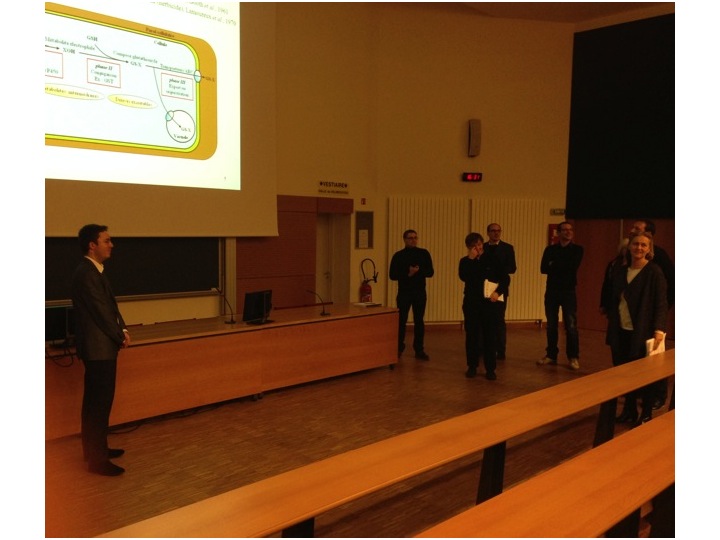Monthly Archives: December 2014
Article: Annals of Forest Science
Abstract
Key message
This paper describes how the combination of genomics, genetic engineering, and 3D structural characterization has helped clarify the redox regulatory networks in poplar with consequences not only in system biology in plants but also in bacteria and mammalian systems.
Context
Tree genomes are increasingly available with a large number of orphan genes coding for proteins, the function of which is still unknown.
Aims and methods
Modern techniques of genome analysis coupled with recombinant protein technology and massive 3D structural determination of tree proteins should help elucidate the function of many of the proteins encoded by orphan genes. X-ray crystallography and NMR will be the methods of choice for protein structure determination.
Results
In this review, we provide examples illustrating how the above-mentioned techniques improved our understanding of redox regulatory circuits in poplar, the first forest tree species sequenced. We showed that poplar peroxiredoxins use either thioredoxin or glutaredoxin as electron donors to reduce hydrogen peroxide. That glutaredoxin could be a reductant was unknown at the time of this discovery even in other biological organisms and was later confirmed notably by the observation that the two genes are fused in some bacteria and by the resolution of the structure of the bacterial hybrid protein. Similarly, genome analysis coupled to in vitro analysis of enzymatic properties led to the discovery that some plant methionine sulfoxide reductases can also use both thioredoxins and glutaredoxins as electron donors. Besides their disulfide reductase activity, it has been demonstrated that some poplar glutaredoxins are also involved in iron-sulfur center biogenesis and assembly. The original 3D structure determination has been made with poplar glutaredoxin C1 and then confirmed in a variety of other biological organisms including human. Our work also showed that in plants, so-called glutathione peroxidases use thioredoxins and not glutathione as electron donors. This is true for all non-selenocysteine-containing glutathione peroxidases. Finally, connections between the thioredoxin and glutaredoxin systems have been elucidated through the study of atypical poplar thioredoxins.
Conclusion
Altogether, these data illustrate how the combination of genetic engineering and structural biology improves our understanding of biological processes and helps fuel systems biology for trees and other biological species.
Article: FEBS letters
PA Lallement, E Meux, JM Gualberto, S Dumarcay, F Favier, C Didierjean, … FEBS Letters
Abstract
Glutathionyl-hydroquinone reductases (GHRs) catalyze the deglutathionylation of quinones via a catalytic cysteine. The two GHR genes in the Populus trichocarpa genome, Pt-GHR1 and Pt-GHR2, are primarily expressed in reproductive organs. Both proteins are localized in plastids. More specifically, Pt-GHR2 localizes in nucleoids. At the structural level, Pt-GHR1 adopts a typical GHR fold, with a dimerization interface comparable to that of the bacterial and fungal GHR counterparts. Pt-GHR1 catalyzes the deglutathionylation of both reduced and oxidized glutathionylated quinones, but the enzyme is more catalytically efficient with the reduced forms.
Seminar: T. Varga
Newcomer: Torda VARGA
New Postdoctoral Researcher: Yohann Daguerre
Newcomer: Jean-Michel Girardet
Article: Frontiers in plant science
The poplar phi class glutathione transferase: expression, activity and structure of GSTF1
Glutathione transferases (GSTs) constitute a superfamily of enzymes with essential roles in cellular detoxification and secondary metabolism in plants as in other organisms. Several plant GSTs, including those of the Phi class (GSTFs), require a conserved catalytic serine residue to perform glutathione (GSH)-conjugation reactions. Genomic analyses revealed that errestrial plants have around 10 GSTFs, 8 in the Populus trichocarpa genome, but their physiological functions and substrates are mostly unknown. Transcript expression analyses showed a predominant expression of all genes both in reproductive (female flowers, fruits, floral buds) and vegetative organs (leaves, petioles). Here, we show that the recombinant poplar GSTF1 (PttGSTF1) possesses peroxidase activity towards cumene hydroperoxide and GSH-conjugation activity towards model substrates such as 2,4-dinitrochlorobenzene, benzyl and phenetyl isothiocyanate, 4-nitrophenyl butyrate and 4-hydroxy-2-nonenal but interestingly not on previously identified GSTF-class substrates. In accordance to analytical gel filtration data, crystal structure of PttGSTF1 showed a canonical dimeric organization with bound GSH or MES molecules. The structure of these protein-substrate complexes allowed delineating the residues contributing to both the G and H sites that form the active site cavity. In sum, the presence of GSTF1 transcripts and proteins in most poplar organs especially those rich in secondary metabolites such as flowers and fruits, together with its GSH-conjugation activity and its documented stress-responsive expression suggest that its function is associated with the catalytic transformation of metabolites and/or peroxide removal rather than with ligandin properties as previously reported for other GSTFs.




